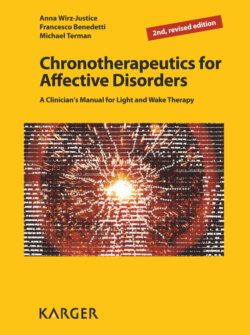Читать книгу Chronotherapeutics for Affective Disorders - M. Terman - Страница 19
На сайте Литреса книга снята с продажи.
1.9 What Is Chronotherapeutics?
ОглавлениеChronotherapeutics encompasses a set of treatments arising from research in chronobiology (light therapy) and from astutely following up clinical observations (sleep deprivation). Psychiatric chronotherapeutics can be defined as controlled exposure to environmental stimuli that act on biological rhythms in order to achieve therapeutic effects in the treatment of psychiatric conditions [25]. The term is broad, although our Manual focuses on affective disorders.
The pineal hormone melatonin, administered as a pill, can, like light, synchronise circadian rhythms and induce sleep [49], and has proved to be very useful for the sleep-wake cycle disorders in persons with visual impairment [50]. Melatonin does not appear to have any major effects on mood by itself.
The major importance of light or melatonin, or both in combination, lies in their zeitgeber characteristics, i.e. their capacity to synchronise or phase shift rhythms. Rhythmic stability appears to be crucial for stable and euthymic mood state [51]. Internal synchronisation means appropriate timing between core body rhythms such as cortisol, temperature, and sleep; external synchronisation means the appropriate timing of these rhythms with respect to the day-night cycle. As a corollary, one can have internal desynchronisation, when the sleep-wake cycle is no longer correctly in phase with the other core body rhythms, and external desynchronisation, when the inner rhythms are out of phase with the day-night cycle. Two obvious examples of the latter are when we move ourselves into another time zone – either by flying there, so that the inner rhythms have to adapt to a new day-night cycle, or by shift work, where the light-dark cycle remains constant, but we have adopted a different, and often changing, relationship to it.
We think that depression reflects a kind of internal desynchronisation. This hypothesis was first tested when we moved sleep 6 h earlier in a bipolar patient who had responded well to sleep deprivation [52] (fig. 12). If, as postulated, her internal clock was phase advanced with respect to her sleep-wake cycle, perhaps her clinical state might be modified by moving sleep earlier to a more correct phase relationship. It was a remarkable experiment. Over a period of about 3 weeks her mood gradually improved, remained stable for a while, and then gradually got worse again. Daily ratings revealed how a circadian rhythm of mood drifted throughout the wake phase, as though a kind of positive jet lag had been induced (fig. 12). After the relapse into depression, her sleep was phase advanced another 6 h, and a similar 3-week time course of improvement was repeated. This single case study laid the basis for the schematic in figure 10: it was not the deprivation of sleep per se that was antidepressant, but rather being awake at a sleep-sensitive circadian phase.
Internal and external synchronisation are thus important for normal healthy functioning. If internal and external synchronisation are even more important for patients vulnerable to depression, then the emphasis of chronotherapeutics on the role of zeitgebers to stabilise circadian rhythm phase can be well understood [51]. Light and melatonin are the most important zeitgebers, but other synchronising factors, such as the regularity of social schedules and meal times, also play a role. The latter factors have been emphasised in the practice of interpersonal social rhythm therapy (IPSRT, section 14), which has been successful with bipolar patients [53]. Surprisingly, regular exposure to dark periods can attenuate the mood swings of rapid cycling disorder [54, 55]: single case reports suggest that wearing blue-blocking sunglasses to avoid the circadian-sensitive wavelength, can also reduce rapid cycling and stabilise mood and sleep. A preliminary trial of 14 h of ‘dark therapy’ per night reduced manic symptoms as rapidly as conventional antipsychotics [56].
In summary, circadian rhythm and sleep research has led to non-pharmacologic therapies of depression – light and wake therapy – that can be conveniently applied in everyday practice.
